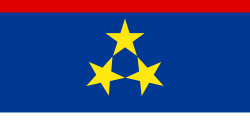Vojvodina
| |||
| |||

|

| ||
| Official languages | Serbian, Hungarian, Slovak, Romanian, Croatian, Rusyn1 | ||
| Capital | Novi Sad | ||
| Area – Total – % water |
21,500 km² n/a | ||
| Population – Total (2002) – Density |
2,031,992 94.51/km² | ||
| Ethnic groups (2002) |
Serbs: 65.05% Hungarians: 14.28% Slovaks: 2.79% Croats: 2.78% Yugoslavs: 2.45% Montenegrins: 1.75% Romanians: 1.5% Roma: 1.43% Others: 7.97% | ||
| 1 All of the official languages are used in the provincial government, Serbian is used in all municipality governments, others are used in selected municipality governments, and few minority languages are used outside official documents | |||
The Autonomous Province of Vojvodina (Serbian: Аутономна Покрајина Војводина or Autonomna Pokrajina Vojvodina) is one of the two autonomous provinces in Serbia. It is located in the northern part of the country, in the Pannonian plain. Its capital and the largest city is Novi Sad and the second largest city is Subotica.
Vojvodina is ethnically, culturally and linguistically diverse, with more than 26 different ethnic groups and six official languages.
Vojvodina Media
Ruins of Arača church
Proclaimed borders of Serbian Vojvodina, 1848
The Annunciation Council in Sremski Karlovci, 1861
"The Monument to Freedom" in Fruška Gora, dedicated to the Yugoslav Partisans' resistance in occupied Vojvodina
The Banovina Palace, seat of the Government of Vojvodina and Assembly of Vojvodina













